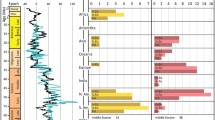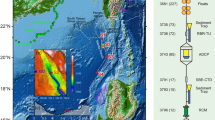Abstract
THE history of many marine sandstones is difficult to determine because the origins of Quaternary sands of offshore shallow seas, to which they may be equivalent, are not yet known. To lessen this gap in our knowledge, a quantitative observational and theoretical study is being made of sand transport and deposition in the southern bight of the North Sea near Holland, for which a qualitative interpretation is already available1. There is probably as much information about currents, sediment grade and sorting, and wave heights and spectra, for this area as for any other sea in the world. In general terms, the southern part has near-surface tidal currents which reach peak speeds of about two knots and the floor of medium sand grade is wrought into large sand waves approximately transverse to the flow. In the northern part, the tidal currents are weaker, and the floor of very well sorted fine sand is flat or probably ripple marked. In between, there is a narrow zone of small sand waves with crest separation of about 10 m (Fig. 1). The inferred net travel of sand is from south to north, with erosion at the southern end and deposition all along the northern reaches of this transport path. The depth of water is only about 80–120 feet; both tidal currents, and wind-produced currents and waves, can be important.
This is a preview of subscription content, access via your institution
Access options
Subscribe to this journal
Receive 51 print issues and online access
$199.00 per year
only $3.90 per issue
Buy this article
- Purchase on Springer Link
- Instant access to full article PDF
Prices may be subject to local taxes which are calculated during checkout
Similar content being viewed by others
References
Stride, A. H., Nature, 206, 498 (1965).
Jones, N. S., Kane, J. M., and Stride, A. H., Mar. Geol., 3, 329 (1965).
Langeraar, W., Hydrogr. Newslett., 1, 5, 243 (1966).
Bruun, P., and Gerritsen, F., Proc. Seventh Conf. Coastal Eng., The Hague, 1960, 1, 386 (1961).
Author information
Authors and Affiliations
Rights and permissions
About this article
Cite this article
JOHNSON, M., STRIDE, A. Geological Significance of North Sea Sand Transport Rates. Nature 224, 1016–1017 (1969). https://doi.org/10.1038/2241016a0
Received:
Revised:
Issue Date:
DOI: https://doi.org/10.1038/2241016a0
Comments
By submitting a comment you agree to abide by our Terms and Community Guidelines. If you find something abusive or that does not comply with our terms or guidelines please flag it as inappropriate.



